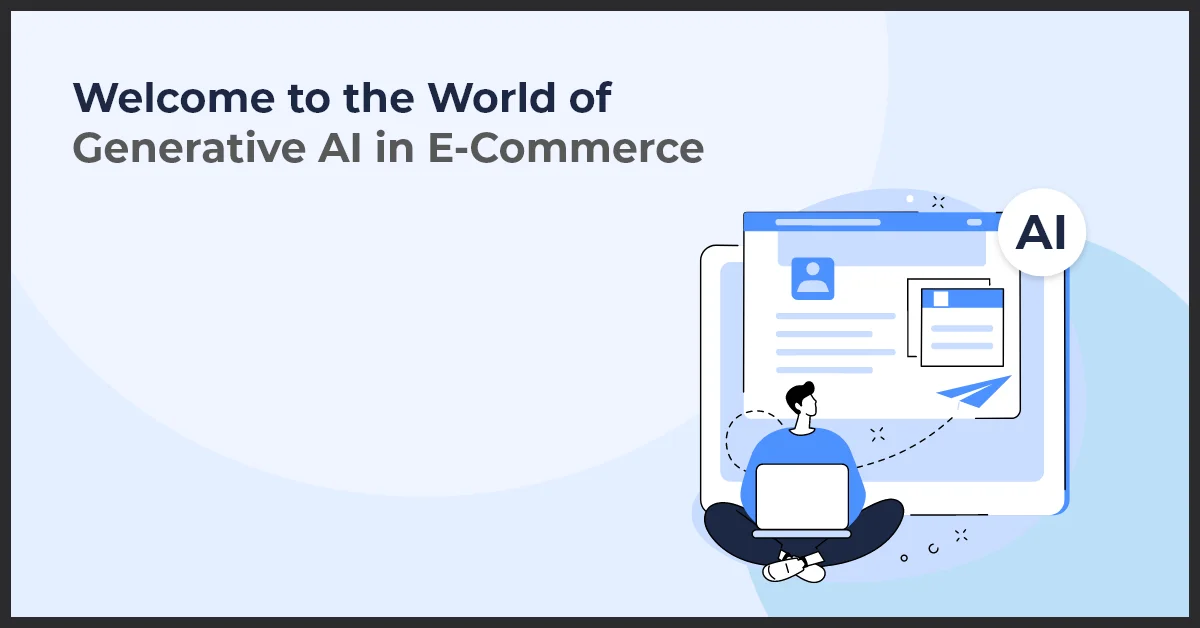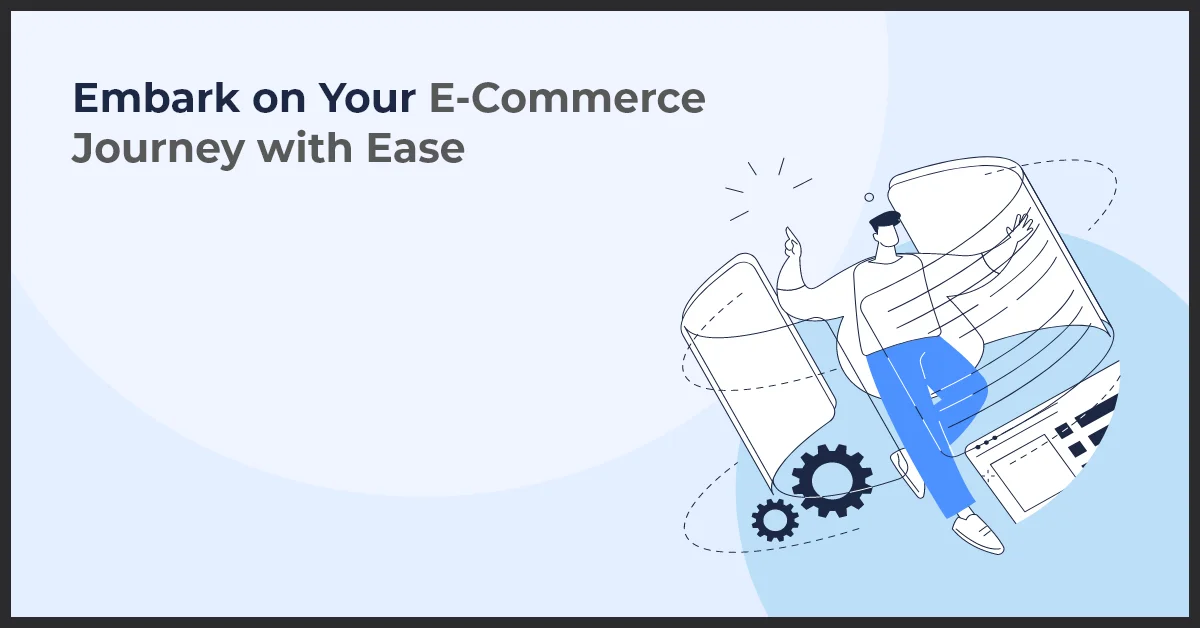Essential Factors for Building a Successful eCommerce Website

Published on: July 2, 2021
Updated on: March 06, 2025
1784 Views
- Ecommerce
20 min read
eCommerce has significantly transformed the retail sector in recent years. Today, the number of people preferring online retail has undoubtedly increased to a new high, with the global eCommerce market likely to touch $4.89 trillion in 2021. The question is, what does an eCommerce website development take to become an ROI machine?
An eCommerce website will prove beneficial only if you provide users with quality time. Your eCommerce website development should, therefore, always begin with a great design concept that is essential to converting your website visitors into valuable customers.
Consider an eCommerce website as identical to a store in a mall. The first impression is most important. Attractive storefronts will attract regular shoppers, and well-organized products will encourage them to browse and shop.
However, as easy as it may seem, it’s a lot of brainstorming, strategizing, and planning put into action. You need to keep in consideration a certain few things before you start developing your eCommerce website. In this blog, we have put together the key points that will help you get your eCommerce website up and running in top shape.
Keep the User in Mind
Every detail of an eCommerce website, from product pages to related pictures and contact forms, may affect a user’s purchase decision. Therefore, when designing your eCommerce website, keeping users’ viewpoints in mind is essential.
Offer Convenience - Add convenient navigation, filtering, and search. Convenience is the number one reason people shop online and the number of users declines if they become confused. The main trend in UX design today is to create websites that make consumer’s lives easier and encourage them to shop easily.
Every element should be simple and jump from one point to another, so that the users do not rush and follow a simple structure to browse the website pages. However, when designing an eCommerce website, it is important to consider the business environment or theme.
For example, for an eCommerce website with 100,000 items, the main question is not how beautiful it looks, but how convenient the search and navigation functions are.
Embed Quality Pictures and Videos on Your Product Page
Since users cannot get hold of the products in real life, they can only rely on the photos and videos displayed on the website. Shopping page design requires high-resolution photos, 360-degree viewing angles, 3D models, and videos. The better the presentation, the more the users will prefer a particular online store.
Any blurriness that uses blurry images might make customers hesitant to buy a product as they assume the product to be cheap. In addition to that, people consider poor-quality pictures a sign of lack of care from the seller, making them go for an alternative site that respects them more.
Like it or not but the consumers only give around 10 seconds of their time while browsing a product, therefore you must have an attention-grabbing design that makes them stay on your page while you can explain the details.
Zoom-In - Another new popular feature in eCommerce websites. The main concept of the zoom-in feature is to give customers a satisfactory level of zooming on the product images to examine the product more closely.
If possible, use images that showcase people using or interacting with your products. For example, clothes worn by models are instantly more attractive to consumers rather than seeing folded clothes laid down or placed on a mannequin.
Essential Features of a Successful eCommerce Website
When you're building an eCommerce website for your business, paying attention to the features that underpin its success is crucial. Let's dive into some of the essentials that you just can't afford to miss:
User-Friendly Design and Site Navigation
Navigating your online store should be a breeze! Customers are looking for an intuitive design that makes finding and purchasing products straightforward and stress-free.
Detailed Item Descriptions and High-Quality Images
Content is king, even in eCommerce. Ensure each product has a detailed description and is showcased with high-quality images to give customers a clear understanding of what they’re buying.
Seamless Shopping Cart and Checkout Experiences
No one likes a complicated checkout process. A seamless shopping cart and an easy-to-navigate checkout experience can mean the difference between a sale and an abandoned cart.
Payment Gateway Integration Options
Offering multiple payment options not only instills trust but also provides the convenience that modern shoppers expect. From credit cards to mobile wallets, being able to integrate a variety of payment gateways is essential for any eCommerce platform.
- User-Friendly Design: Keep it simple and intuitive for users to navigate.
- Detailed Descriptions: For all you wordsmiths out there, here's where you shine—craft descriptions that sell.
- Quality Images: They say a picture is worth a thousand words, so make every pixel count.
- Seamless Shopping Cart: Don't let a clunky cart be the reason your customers leave.
- Multiple Payment Options: Because who doesn't love options, especially when it comes to paying?
Seamless Shopping with Payment Gateway Integration
Let's face it: nobody enjoys a complicated checkout process. That's why integrating a seamless payment gateway on your eCommerce website is like rolling out the red carpet for your customers' shopping experience. When your checkout is as smooth as butter, customers are more likely to return for repeat purchases. Let's dive into what makes a payment gateway integration an absolute must-have for your business.
Simplifying the Payment Process for Customers
The checkout process is the grand finale of a customer's shopping journey on your website. You want it to be as swift and straightforward as possible. Integrating a user-friendly payment gateway ensures that this critical step isn't a hurdle but rather a pleasant last touch encouraging future visits.
Ensuring a Wide Range of Payment Options
Everyone has their payment preferences, and catering to them all can seem daunting. Fear not! By implementing a versatile payment gateway, you can offer a smorgasbord of payment methods. Whether it's credit cards, e-wallets, or bank transfers, your customers will appreciate the versatility at their fingertips.
Discussion on the Security of Transactions
But let's talk turkey: the security of online transactions is paramount. You don't want your customers fretting about the safety of their financial data. Rest assured, integrating a reputable payment gateway comes with top-notch security measures to safeguard every transaction. SSL encryption, fraud protection, and PCI DSS compliance are all part of the package, giving both you and your customers peace of mind.
- Streamlined checkout boosts customer satisfaction and retention.
- Multiple payment options cater to a broader audience.
- Advanced security measures protect against data breaches and build trust.
Fortify Your Online Store with Top-Notch Security and SSL
When it comes to eCommerce, securing your online transactions is not just an option—it's an absolute necessity. By integrating SSL certificates, your business creates a secure and trustworthy environment for shoppers. Let's dive into the pivotal role that security plays in the success of your eCommerce website.
The Role of SSL Certificates in Building Customer Trust
Imagine SSL certificates as the steadfast guards of your eCommerce realm. They encrypt the data transfer between your site and your customers, ensuring all personal and payment information is kept confidential. This encryption builds a foundation of trust, showing customers that their safety is your top priority—a critical factor in fostering long-term customer relationships.
Compliance with Security Standards (PCI DSS)
Adhering to security protocols isn't just about good practice; it's about compliance. The Payment Card Industry Data Security Standard (PCI DSS) sets the bar for safeguarding cardholder information. Don't let compliance be an afterthought—make sure your platform keeps up with these standards to avoid costly breaches and fines.
Importance of Data Protection for Business and Customer
Data breaches are a nightmare scenario for any business. They can lead to significant financial loss, damage to reputation, and erosion of customer trust. By prioritizing data protection through SSL certificates, you're not just protecting your customers—you're fortifying your business against potential threats that can harm your bottom line and your brand's image.
- Proactive Security Measures: Go beyond the basics by implementing additional layers of security to complement your SSL certificates.
- Regular Updates: Technology evolves, and so do threats. Regular updates to your security systems are crucial in keeping your eCommerce site a safe haven for shoppers.
- Customer Education: Inform your customers about the significance of SSL and secure shopping—it’s a powerful way to reinforce their confidence in your brand.
Master Your eCommerce Universe with Stellar Product Catalog Management
Gone are the days when managing a product catalog was like herding cats. Today, with the right know-how, your eCommerce website can showcase your items in perfect harmony, making it a breeze for customers to find exactly what they need. Let's dig into the essentials of product catalog management!
Organizing Your Items for Easy Navigation
Navigating an eCommerce site should feel like taking a leisurely stroll through your favorite store. Everything is where you expect it to be, leading to a wonderfully effortless shopping experience. That's why organizing your products is crucial—think intuitive categories, filters, and search functions. Ensure your customers can find their heart's desire without any fuss!
Importance of Accurate and Detailed Item Information
Let's be real—no one buys a pig in a poke online. Shoppers want the nitty-gritty on what they're eyeing. This means having accurate and detailed product descriptions, high-quality images, and spec sheets. The goal? To arm them with enough confidence to hit the 'Buy Now' button without second-guessing their choice.
Tools to Manage Product Listings Efficiently
Behind every seamless online store is a merchant with top-tier tools at their disposal. A robust product management system saves you from the chaos of spreadsheets, allowing you to add, update, and track your inventory like a pro. Streamlining your workflow not only keeps your gray hairs at bay but also ensures your customers get consistent, up-to-date information.
- When selecting tools, look for features that mesh with your business needs. Flexibility is your friend.
- Automation features? Yes, please! Anything to save time on tedious tasks.
- And don't forget about scalability. You want a system that grows with your business, not one that you outgrow faster than a pair of kid's sneakers!
Equip yourself with solid product catalog management techniques, and watch as your eCommerce website turns into a well-oiled sales machine. Happy organizing!
Efficient Order Processing: The Backbone of Your eCommerce Website
As you dive into the realm of online sales, understand that your eCommerce website is more than a digital storefront; it's the pivotal platform where a simple click translates into a complex series of actions. Streamlining your order processing and fulfillment strategy is crucial for ensuring customer satisfaction and repeat business.
Streamlining the Order-to-Fulfillment Process
Order processing should be seamless for both you and your customers. From the moment a customer checks out, to the second their package is delivered, every step needs to be smooth and efficient. This not only builds trust but also encourages customers to come back for more.
- Automating the Order Process: By automating steps like order confirmation, invoicing, and shipping label creation, you reduce the risk of human error and free up time to focus on other areas of your business.
- Inventory Syncing: Real-time inventory updates ensure that what customers see online is what's actually available, helping to avoid overselling and ensuring efficient order fulfillment.
Automating Notifications and Status Updates for Customers
Communication is key in reinforcing customer confidence. Automated notifications keep your customers in the loop at every stage:
- Order confirmation emails show them you've received their order.
- Shipping updates with tracking information let them know their purchase is on the way.
- Delivery confirmation messages assure them their package has arrived.
Challenges and Solutions in Logistics
Logistics can be one of the trickiest aspects of running an eCommerce website. From finding the most cost-effective shipping options to handling returns, challenges are part of the package—literally.
Some common hurdles include:
- Choosing the right shipping partners to balance speed and cost.
- Managing international shipments and understanding customs regulations.
- Implementing an easy and clear returns policy.
Addressing these challenges with strategic planning and the right logistics partnerships ensures that your customers receive their orders promptly and accurately, keeping them satisfied and loyal to your brand.
In conclusion, the order processing and fulfillment aspect of your eCommerce website is the final, and perhaps most vital, stage in the customer's journey. By focusing on efficiency and transparency, you'll be well on your way to establishing a robust and reliable online presence that customers can trust time and time again.
Unlock the Power of Data with Analytics and Reporting Tools
In the digital age, understanding the intricacies of your online business environment is crucial. Analytics and reporting tools are like the navigational compass for steering your eCommerce website toward success. They provide a clear view of your sales data and customer behavior, letting you make informed decisions that can significantly impact your business’s growth and profitability.
Can you really afford to guess your way forward? We think not! With the wealth of data at your fingertips, you need to harness these insights to tailor your strategies and offerings. Let’s dive into how utilizing robust analytics tools can transform your business.
Interpreting Sales Data and Customer Behavior
Knowing where your customers come from, what they look at, and what they buy can tell a story that goes beyond mere numbers. It’s about discovering patterns, identifying successful products, and highlighting areas that need improvement. By keeping a close eye on customer interactions with your site, you can fine-tune the user experience to better meet their needs—and your business goals.
Using Analytics for Informed Business Decisions
Think of analytics as your silent business advisor. Whether it's about optimizing your marketing efforts, managing inventory or setting the right price, data-driven decisions are the key to staying competitive. By understanding how different aspects of your site contribute to your bottom line, you can allocate resources more efficiently and with greater confidence.
Tools and Platforms That Offer Actionable Insights
Settling on the right tools is critical. Platforms like Google Analytics, Adobe Analytics, and specialized eCommerce analytics services can illuminate various aspects of your business. These platforms provide:
- Real-time data analysis
- Customer segmentation and tracking
- Conversion tracking and attribution modeling
- Behavioral analysis through heatmaps and session recording
With these instruments, not only do you get to see what’s happening, but you also understand why it’s happening. This allows you to devise tailored marketing campaigns, optimize your checkout process, or rework your site’s navigation to better suit your audience—giving them more reasons to shop with you.
Scalability and Growth Planning: Future-proofing Your eCommerce Business
Why is scalability so crucial for your online store? Well, imagine your eCommerce website as a living entity; it needs room to grow and evolve just as your business does. Without the right planning and infrastructure, your site might become sluggish with increased traffic, or you may find it hard to adapt to market changes, ultimately limiting your business potential. Let’s dive into how you can prepare for your eCommerce website’s growth and make sure it continues to thrive.
Preparing the Platform Infrastructure for Traffic Growth
First things first: make sure your eCommerce platform can handle success. This means having robust hosting solutions that can scale up resources as traffic spikes. You never know when a product might go viral or a holiday sale could attract a flood of shoppers. Being proactive with your platform's infrastructure ensures you're never caught off guard by your own success.
Strategies for Expanding Your Item Catalog and Entering New Markets
As your business grows, so should your product offerings and target audience. Strategizing expansion involves:
- Researching market trends and customer demand,
- Addition of complementary products to leverage cross-selling,
- Testing and validation of new market viability, and
- Implementing localization strategies to connect with audiences in different regions.
Capitalizing on a diverse product range and broader market reach can be a game-changer for your business growth.
Continuous Improvement and Keeping Up with eCommerce Trends
The only constant in eCommerce is change. Staying on top of technological advancements, user expectations, and industry standards is a must. Continuous improvement isn’t a one-time task; it’s an ongoing commitment. This includes regularly updating your website, incorporating user feedback, and embracing innovations like AI, AR, and personalization to stay ahead of the curve.
Planning for scalability isn’t just about handling more customers or selling more products; it’s about cultivating an eCommerce environment that’s flexible, resilient, and constantly evolving. Prepare, adapt, and grow—that’s the motto for a successful eCommerce business.
Make Your Site SEO-Friendly
Your online store has to acquire more visitors to increase sales. Search Engine Optimization (SEO) is the key to generating more traffic. By incorporating search engine marketing key phrases into your product titles and descriptions, your website is likely to rank better in search engine results. Having better visibility is a key factor in website traffic and conversions.
PageRank is critical to traffic. Using the right search engine optimization can make your page rank higher on SERPs. Page performance and page loading speed also contribute to UX and Google rankings.
Impatient buyers abandon slow websites almost immediately. Make use of search engine optimization tools to measure the month-to-month search quantity and the difficulty level of the associated keyword terms.
Terms that have excessive monthly search volumes will be more difficult to evaluate. Also, Google Analytics can help with tracking the page views of blog posts. When planning future content, take into consideration the previous high-engagement posts.
Ensure Your Store is Mobile-Responsive
Optimizing all websites for mobile devices may not seem difficult, but there are still thousands of vendors connected to old themes and websites that only display correctly on PC browsers. It is not an ideal approach when setting up an eCommerce website as nearly 50% of websites are opened from mobile devices.
Nearly 79% of mobile users have made at least one online purchase in the last 6 months and as smartphones and tablets become more sophisticated, it is expected that this percentage will only increase.
Having responsive design allows your eCommerce website to adapt to any type of screen resolution or operating system and they should be able to provide mobile users with a hassle-free mobile-friendly interface.
If the eCommerce website is not optimized for mobile devices, all the user interface elements and text are displayed in the wrong font size when they browse through the site and prove to be extremely difficult to use on a small screen device.
In a nutshell, mobile users who are unable to interact with the website properly will probably abandon your brand and visit alternate e-commerce websites with a mobile-friendly interface.
Security of Customers is Vital
Since online transactions are an inevitable part of all the customers using eCommerce websites, it is expected that many hackers will target their credit card credentials. Security measures should already be up and running before opening the eCommerce website to the general public.
Your eCommerce platform should be secured at its initial stages or else bad reviews about the safety will damage your brand’s reputation and prove detrimental to the business.
Implement privacy policies to protect customer data who use your eCommerce website and assure them that any information they share with you is safe. Obtain SSL certification for your eCommerce store to establish a secure connection between the user and the website and make sure the SSL certificate is from a recognized vendor.
Two-stage authentication is another means to secure your customers’ data by using a system-generated code sent via email or SMS. You can also use a firewall to protect the bridge between two networks and block any malicious traffic in its tracks.
Product Navigation and Functionality
Clunky eCommerce websites are a major letdown for customers as it decreases their efficiency to search products. Nearly 40% of customers wait for three seconds for the website to load, especially when using a mobile device.
Have convenient modes of navigation between categories and provide filter options for price range, color, product type, etc. Easier navigation increases the probability of your customers finding the product they are looking for and encourages them to make purchases in the future.
Keep in mind that all your customers might not be tech-savvy. So, your website should be user-friendly to even novice users. eCommerce websites should also provide search functionality for the users who are looking for items without having to go through all the pages.
If you can successfully help the customers in finding what they were looking for, you will have a higher probability of closing a sale. You can use special sections like “You may like this” and “People who bought this item also searched for…” paired with related products to pique their curiosity and capitalize on the opportunity to sell multiple products.
Ratings and User-Generated Reviews
Customers believe the positive descriptions put by the seller blindly. In fact, they prefer the inputs of customers who bought and used the products.
The importance of these reviews is evident as 95% of the customers browsing through eCommerce websites, read the reviews. Ratings are also a deciding factor for purchase as 57% of customers won't buy a product if it has a poor rating. Make sure you deliver quality products to prevent bad ratings that damage the overall reputation of your brand.
Please note, it is not a good idea to use immoral methods to artificially boost your ratings and reviews. Manufacturing reviews only work for a while but prove to be detrimental for the business in the long run.
Payment Processing
Enable different modes of payment to attract a larger audience as not everyone would prefer a specific payment method. Offer added convenience to customers by providing payment methods like Cash on delivery, Credit, Debit, and Paypal, to name a few.
One of the biggest factors that cause cart abandonment is unexpected additional costs added at the last moment of purchase. Maintaining transparency about payments keeps the customer informed about the expenses in advance and doesn’t catch them off guard.
Free shipping is an attractive option that motivates a customer into completing a purchase. Most companies see the benefits of free shipping and implement it when customers reach a certain threshold.
93% of online buyers are encouraged to buy more products if they get free shipping options, while 61% of customers are likely to cancel their purchase due to the lack of free shipping.
FAQs Section
With the lack of face-to-face interaction between buyers and sellers in online shopping, the best way to instill confidence in customers is by providing all the information about the product on the website itself. How?
- By offering authentic production information in the listing
- Having a FAQ section on the website that reveals information about the purchase, returns, and other website policies
You can also expedite the customer service process by implementing Chatbots instead of letting them wait in the queue on a helpline. Chatbots can answer commonly asked questions and offer order status when connected to your website’s database.
Conclusion
In the modern age, an eCommerce website will be extremely beneficial for your enterprise even if you own brick and mortar stores. A website would not only boost sales but also establish your business on a global scale.
Creating a game-changing eCommerce website requires a lot of time and effort. With the correct steps and providing your customers with modern features and security, you can win over new customers and convert them into brand advocates. Establish your website and focus on maintaining the quality from day one to ensure your site is always functioning properly.
Want to learn more about starting a kickass eCommerce business? Email us at info@growthnatives.com or visit our website.



